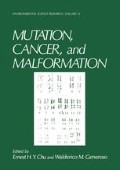Summary
China is a developing country, having a population of over one billion people. Of course, she has her own special conditions of climate, environment, flora and fauna. Along with the progress of modernization, the country is also facing the problem of environmental pollution through the release of industrial wastes into the air and waterways. This, together with population pressure and agricultural problems, has already received the wide attention of the Chinese public. China is prepared to exercise quality control and environmental monitoring, and the application of basic scientific methodology to the solution of practical problems has been found essential to the development of genetic toxicology. Some 30 to 40 independent qualified laboratories for identifying mutagens are now operating in China. They are distributed over more than 15 provinces. Most of these assays are used to help identify mutagens, some can also identify carcinogens. Of these laboratories, two-thirds are working mutagenetic assays and the other one-third is doing either carcinogenetic or teratogenetic assays. The in vitro assays use a variety of cell types ranging from bacterial to human, from somatic cells to germ cells; other tests can be done directly on insects, rodents and plants. With a regulatory framework gradually taking shape, mutagenicity testing is becoming a big business. Nowadays, all new drugs, pesticides, food additives, contraceptives, and even certain suspect traditional Chinese medicinal herbs are subjected to the Ames test, micronucleus test, chromosome aberrations and SCE analysis of mouse bone-marrow cells in routine screening procedures. At present, our research studies in the field of environmental mutagenesis, carcinogenesis and teratogenesis place more emphasis on the practical and applied aspects. In the long run, however, it is conceivable that attention will also be directed to the quantitative approaches and mechanism will also be directed to the quantitative approaches and mechanism studies in order to contribute substantially to closing the gap between the basic and applied works.
Access this chapter
Tax calculation will be finalised at checkout
Purchases are for personal use only
Preview
Unable to display preview. Download preview PDF.
References
Cao, Z. Y. (1979) The observations of lymphocyte chromosome aberrations in uranium workers (I).Radiation Protection1: 21 – 24.
Cao, Z. Y. (1979) The observations of lymphocyte chromosome aberrations in uranium workers (II).Radiation Protection1: 25 – 28.
Cao, Z. Y. (1979) The observations of lymphocyte chromosome aberrations in uranium workers (II).Radiation Protection1: 25 – 28.
Hsueh/ J. L. , and W. Xiang (1983) A concise report on environmental mutagenesis research in our laboratory. International Workshop on Environmental Mutagenesis, Carcinogenesis, and Teratogenesis, Shanghai, People’s Republic of China, May 1983.
Li, C. B. , F. Ding, Z. R. Ma, and S. Y. Zhao (1981) The determination of the male contraceptive gossypol as a non- mutagenic agent by the Ames test and SCE method.Fudan J. (Natural Science) 20 (4): 361 – 365.
Tsui, Y. C. , M. R. Creasy, and M. A. Hulten (1983) The effect of gossypol on human lyirphocytes in vitro: Cell kinetics, traditional chromosome breakage, micronuclei and sister chromatid exchange.J. Med. Genet. 20: 81 – 85.
Wang, H. W. , R. W. Dzeng, and D. Wang (1982) The carcinogenicity of N-phenyl-2-naphthy-L-amine on ICR mice.Acta Biol. Exper. Sinica15: 199 – 207.
Wang, H. W. , R. J. Shen, and R. W. Dzeng (1981) The carcinogenic activity of antioxidant D on C57/BL mice. ActaBiol. Exper.Sinica14: 129 – 135.
Wang, D. , and H. W. Vfang (1981) Experimental studies on carcinogenicity of refined antiox D on Wistar rats.Tumor1: 1 – 2.
Vfang, H. W. , and D. Wang (1981) The synergistic action of antioxidant D and carbon tetrachloride on rat liver.Acta Biol. Exper. Sinica14: 371 – 377.
Wang, H. W. , D. Wang, P. X. Tang, R. J. Shen, and R. W. Zeng (1981) The carcinogenic activity of antioxidant D on albino rats.Acta Biol. Exper. Sinica14: 77 – 85.
Wkng, D. , R. W. Zeng, and H. W. Wkng (1982) Comparison of carcinogenicity of antiox D to TA-1 and ICR strains of mice. Shanghai Commun.Animal Husb. Vet. Med. 2: 9 – 11.
Yu, Y. N. , C. Ding, X. R. Chen, and Q. G. Li. A rapid and simple procedure for measurement of unscheduled DNA synthesis in cultured human cell line suitable for screening the DNA- damaging effects of chemicals.Scientia Sinica(submitted for publication).
Yu, Y. N. , C. Ding, X. R. Chen, Q. G. Li, X. M. Yao, and S. Z. Zhang. Caramel, a DNA-damaging agent.Chinese Med. J. (submitted for publication).
Zhang, Z. S. , X. X. Pan, M. M. Wang, and Y. I. Yao (1981) Genetic studies of the gossypol I. The comparative studies of cytogenetic effects of gossypol acetate on male germ cells and lymphocytes in blood of the micronucleus test in rats.Reproduction and Contraception1 (1): 33 – 36.
Zhou, J. M. , Q. Lu, and S. H. Jiang (1982) Effects of gossypol on germ cell chromosomes in mice.Reproduction and Contraception2: 49 – 52.
Author information
Authors and Affiliations
Editor information
Editors and Affiliations
Rights and permissions
Copyright information
© 1984 Plenum Press, New York
About this chapter
Cite this chapter
Tan, C.C., Hsueh, J.L. (1984). Research Progress on Environmental Mutagenesis, Carcinogenesis and Teratogenesis in China. In: Chu, E.H.Y., Generoso, W.M. (eds) Mutation, Cancer, and Malformation. Environmental Science Research, vol 31. Springer, Boston, MA. https://doi.org/10.1007/978-1-4613-2399-0_32
Download citation
DOI: https://doi.org/10.1007/978-1-4613-2399-0_32
Publisher Name: Springer, Boston, MA
Print ISBN: 978-1-4612-9463-4
Online ISBN: 978-1-4613-2399-0
eBook Packages: Springer Book Archive

